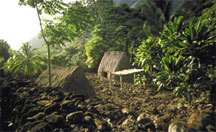The History of Hawaiian Architecture
The architecture of Hawaii tells the story of her history; from Hawaiian’s of ancient times through the kingdom era, from its territorial years to statehood and beyond. It tells the story of how the indigenous native Hawaiians and their complex society in ancient times slowly evolved with the infusion of new styles brought to its shores, from the early European traders, the missions of the New Englanders and French Catholics, the plantation laborer cultures from the Orient to the influences of modern times. It is also a reflection of her unique climate and natural building materials that abound from coastal regions to the higher elevations of her mountain ranges.
Today, the best of Hawaii’s architects consider and reflect the uniqueness of the Hawaiian culture and history, it’s native building materials and its unique climate when designing a new home or commercial space.
In this article, we highlight a few of the most important architecture periods that continue to influence Hawaiian Architecture style today.
Ancient Hawaii
The earliest form of Hawaiian architecture originates from what is referred to as Ancient Hawaii which spans the period of time from the arrival of the first Polynesian settlers to the Hawaiian islands (believed to be in the 3rd century) until the unification of the Kingdom of Hawaii by Kamehameha the Great in 1810. Natural materials such as lava, coral, lumber and thatching from coconut are just some of the materials that were employed.


The way a simple grass shack was constructed in ancient Hawaii was telling of who lived in a particular home. The patterns in which dried plants and lumber were fashioned together could identify the caste, skill and trade, profession and wealth of its inhabitants. The abode of royalty (ali’i) was most often palatial thatched homes on raised lava rock foundation. Feather standards called kahili adorned with kappa cloth and crossed at the entrance of certain homes called pulo’ulo’u also indicated places of royalty.
Hawaiian Mission Architecture
Traditional Hawaiian architecture experienced its first revolution with the arrival of the missionaries, starting in 1823. Used to the Congregational meeting house structures and farmhouses they had lived in on the east coast of the United States, they sought to duplicate their style in Hawaii. Their influence includes erecting the first frame houses, with high-pitched roofs and overlapping weatherboards called clapboards. With time, this style evolved into a distinctive style called Hawaiian Mission Architecture. New England methods and materials were replaced by methods and materials readily available to Hawaiians such as coral blocks for foundation and walls. According to Hunton Conrad, “some of the buildings from this era were built of coral block and a mortar made from burning coral.”
The Catholic Missionaries also came to Hawaii around this time and with the construction of their churches they brought European influences including classical, renaissance, rococo and neoclassical.

Hawaiian Renaissance Architecture
It was Kamehameha the V, in 1850, who heralded the development of Hawaiian Renaissance architecture, which evolved with time to encompass both the traditional Roman architectural principals as well as concepts of Hawaiiana. He wanted a palace inspired by the sleek beauty of historic Italian structures. His vision and delight in Hawaiian Renaissance architecture was shared by his successor, King David Kalakau who also dreamt of erecting a world-class royal palace. His vision was realized with the completion of Iolani Palace in 1882.

Plantation Style
At the same time that the monarchy and various corporations developed downtown Honolulu with their renditions of Hawaiian Renaissance styles, residential homes were being built in the outskirts of the city and elsewhere in the state. These houses reflected the styles of the sugarcane and pineapple plantations where laborers lived. The style features low profile wood frames, vertical plank siding and large porticos. Roofs were the most distinguishable parts of Hawaiian plantation structures as they were wide-hipped or bellcast and had eaves that were deep bracketed. When viewed against the natural Hawaiian environment, Hawaiian plantation structures look as though they blend easily with their surroundings. This style continues as an important influence in Hawaiian architecture today.

Hunton Conrad & Associates
P.O. Box 653
Kula, Hawai'i 96790
(808) 878-2924
Fax: (808) 876-0595
e-mail: info@huntonconrad.com



